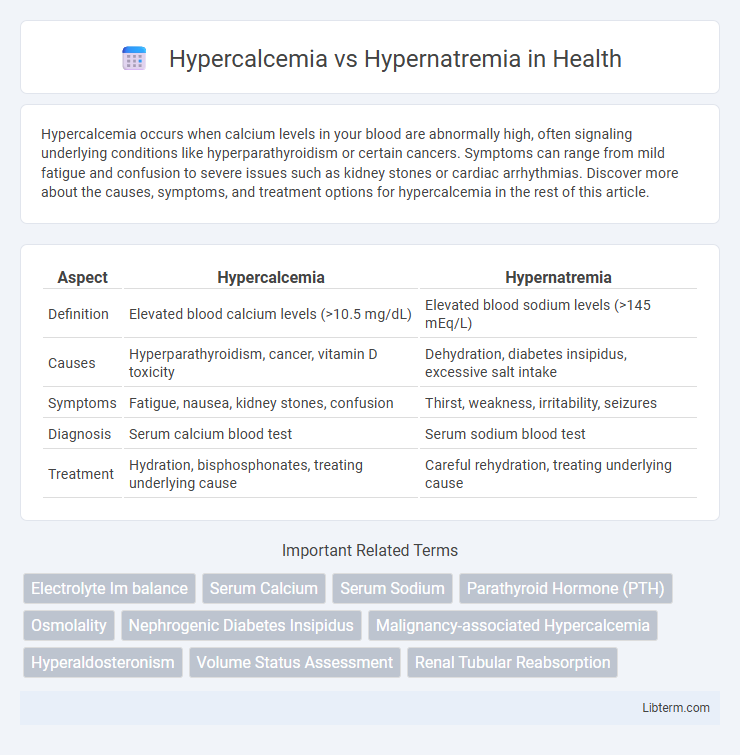Hypercalcemia occurs when calcium levels in your blood are abnormally high, often signaling underlying conditions like hyperparathyroidism or certain cancers. Symptoms can range from mild fatigue and confusion to severe issues such as kidney stones or cardiac arrhythmias. Discover more about the causes, symptoms, and treatment options for hypercalcemia in the rest of this article.
Table of Comparison
| Aspect | Hypercalcemia | Hypernatremia |
|---|---|---|
| Definition | Elevated blood calcium levels (>10.5 mg/dL) | Elevated blood sodium levels (>145 mEq/L) |
| Causes | Hyperparathyroidism, cancer, vitamin D toxicity | Dehydration, diabetes insipidus, excessive salt intake |
| Symptoms | Fatigue, nausea, kidney stones, confusion | Thirst, weakness, irritability, seizures |
| Diagnosis | Serum calcium blood test | Serum sodium blood test |
| Treatment | Hydration, bisphosphonates, treating underlying cause | Careful rehydration, treating underlying cause |
Introduction to Hypercalcemia and Hypernatremia
Hypercalcemia is a metabolic condition characterized by elevated calcium levels in the blood, typically exceeding 10.5 mg/dL, and often results from hyperparathyroidism, malignancies, or excessive vitamin D intake. Hypernatremia involves an abnormal increase in sodium concentration above 145 mmol/L, frequently caused by dehydration, kidney dysfunction, or excessive sodium intake. Both disorders disrupt electrolyte balance and can lead to critical neurological and cardiovascular complications if not promptly managed.
Definition and Overview
Hypercalcemia is a medical condition characterized by elevated calcium levels in the blood, typically above 10.5 mg/dL, often caused by hyperparathyroidism or malignancies. Hypernatremia refers to an excessive concentration of sodium in the blood, generally exceeding 145 mEq/L, frequently resulting from dehydration or impaired renal function. Both conditions disrupt electrolyte balance but involve different ions and distinct physiological impacts.
Causes of Hypercalcemia
Hypercalcemia primarily results from hyperparathyroidism, malignancies such as breast or lung cancer with bone metastases, and excessive vitamin D or calcium supplementation. Other causes include granulomatous diseases like sarcoidosis, certain medications like thiazide diuretics, and immobilization. Identifying these underlying factors is crucial for appropriate diagnosis and treatment.
Causes of Hypernatremia
Hypernatremia primarily results from water loss exceeding sodium loss, often caused by inadequate water intake, excessive sweating, or diabetes insipidus. Other significant causes include osmotic diuresis, vomiting, and certain medications like diuretics. Understanding these causes is critical for distinguishing hypernatremia from hypercalcemia, which typically arises from hyperparathyroidism or malignancy rather than fluid imbalance.
Signs and Symptoms Comparison
Hypercalcemia commonly presents with symptoms such as muscle weakness, fatigue, polyuria, and neuropsychiatric disturbances like confusion and depression, while hypernatremia primarily causes thirst, irritability, lethargy, and, in severe cases, seizures or coma due to cellular dehydration. Hypercalcemia may also induce gastrointestinal symptoms including nausea, vomiting, and constipation, whereas hypernatremia often leads to dry mucous membranes and decreased skin turgor. Both conditions disrupt electrolyte balance but manifest distinctly due to their different pathophysiological mechanisms affecting calcium and sodium levels.
Diagnostic Approaches
Hypercalcemia diagnosis relies on serum calcium measurements corrected for albumin levels, alongside parathyroid hormone (PTH) assays to differentiate between primary hyperparathyroidism and malignancy-related causes. Hypernatremia is identified through elevated serum sodium concentration above 145 mmol/L, with volume status assessment and urine osmolality tests guiding the evaluation of underlying dehydration, diabetes insipidus, or renal concentrating defects. Both conditions require targeted lab panels and clinical correlation to establish etiology and guide appropriate treatment strategies.
Pathophysiology: Calcium vs Sodium Imbalance
Hypercalcemia occurs due to increased calcium release from bones, augmented intestinal absorption, or decreased renal excretion, often linked to hyperparathyroidism or malignancies. Hypernatremia results from excessive sodium retention or water loss leading to increased plasma osmolality and cellular dehydration, commonly caused by dehydration or mineralocorticoid excess. Both imbalances disrupt cellular functions, but calcium primarily affects neuromuscular excitability and intracellular signaling, while sodium imbalance impacts extracellular fluid volume and neuronal function.
Treatment Strategies
Treatment strategies for hypercalcemia focus on reducing serum calcium levels through intravenous hydration with isotonic saline, administration of bisphosphonates to inhibit bone resorption, and corticosteroids in cases related to granulomatous diseases. Hypernatremia management centers on correcting water deficits via controlled hypotonic fluid administration, addressing underlying causes like diabetes insipidus or excessive sodium intake, and monitoring serum sodium closely to prevent rapid shifts. Both conditions require tailored approaches to safely restore electrolyte balance while preventing complications such as cardiac arrhythmias or cerebral edema.
Complications and Prognosis
Hypercalcemia can lead to complications such as kidney stones, bone pain, and cardiac arrhythmias, with severe cases causing neurocognitive impairments and kidney failure, often indicating underlying malignancy or hyperparathyroidism that affects prognosis. Hypernatremia primarily causes neurological symptoms including confusion, seizures, and coma due to cellular dehydration, with prognosis dependent on the rapidity of onset and correction, as overly rapid treatment risks cerebral edema. Both electrolyte imbalances require prompt diagnosis and tailored management to prevent irreversible organ damage and improve patient outcomes.
Prevention and Patient Management
Effective prevention of hypercalcemia involves maintaining balanced calcium intake, monitoring serum calcium levels regularly in at-risk patients, and managing underlying conditions such as hyperparathyroidism or malignancies. Hypernatremia prevention focuses on ensuring adequate hydration, careful monitoring of sodium levels, especially in patients with impaired kidney function or those receiving sodium-rich medications, and adjusting fluid therapy accordingly. Patient management for both conditions requires prompt identification of symptoms, tailored treatment plans including fluid management, electrolyte correction, and addressing the root causes to prevent complications like cardiac arrhythmias or neurological deficits.
Hypercalcemia Infographic

 libterm.com
libterm.com